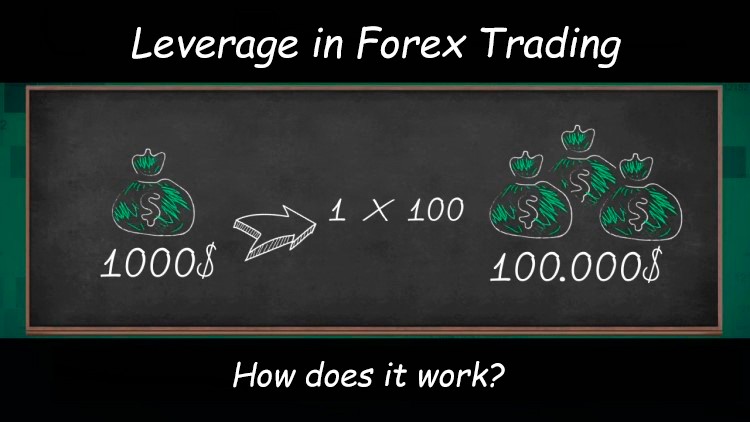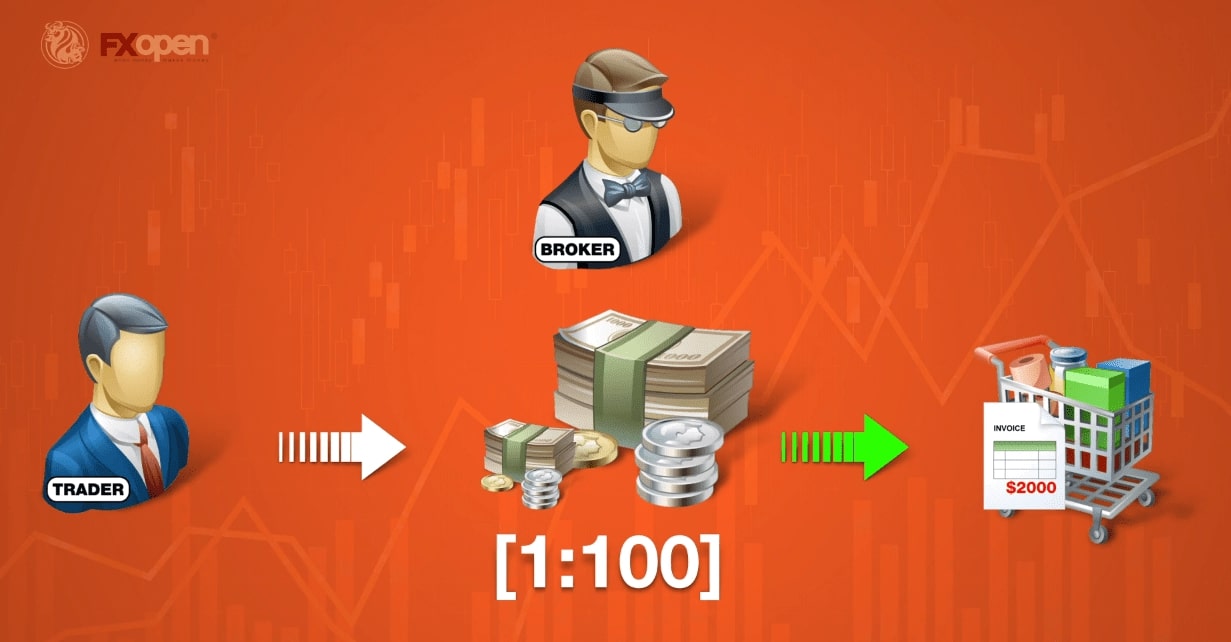FXOpen

[Update August 28, 2020]
Leverage may not be the easiest concept, especially for beginner traders. However, it is these virtual funds that a brokerage company provides to its clients that are a common reason why people choose to go trading on the Forex market. Therefore, in this article, we decided to provide a clear definition of leverage, its advantages and disadvantages, and how to use it properly.
What is leverage in Forex?
To understand what is Forex leverage, imagine a situation when a trade is made for money borrowed from a third party. In the Forex market, a broker can “lend” money to a trader, which allows the latter to open significantly larger positions as if he has more funds in his trading account. However, it also means that the trader will incur losses in the same proportion. Leverage shows the ratio of borrowed funds to the trader’s own deposits.
How does Forex leverage work?
Let’s have leverage in trading explained by a simple example. Imagine you need $100,000 to make a trade, but you have only $50,000. So you borrow the missing money against your deposit. This ratio of your own money to the value of the loan is called leverage. In your case, it’s 2:1. But it may also be 10:1, 50:1, 100:1, etc.
The higher the leverage, the less your own money you put into the deal. For example, when opening a deal for $100,000 with leverage of 1:1, you need to invest the whole $100,000 of your own money. But when trading with leverage of 1:20, the amount of deposit will be reduced to $5000!
So does leverage increase profit? This question does not have a simple “Yes” or “No” answer. Leverage allows you to open trades for large amounts. If the market goes in the right direction for the trader, their profits may be several times higher than if they were trading with no leverage. but the risk also increases proportionally. When used wisely, the lever may quickly increase your capital.
How to use leverage in Forex trading?
Now that you have an overview of what is leverage trading, let’s look at ways of using it.
When a position is opened in the Forex market, the market moves either towards the trader’s position or against it. Each pip in the price movement corresponds to a fixed amount of capital that is added to or deducted from the trading account balance. If the market moves in the direction of a trader’s position, the trader earns money; if not, the trader suffers a loss.
Currency trading is performed as “contracts” for a certain number of so-called standard lots. Each lot is equivalent to 100,000 currency units. If the US dollar is used as a quote currency and trader opens a position for one standard lot, he buys or sells 100,000 units of this currency.
Since the currency price movement is measured in pips (each pip corresponds to a share of 0.0001) when trading a standard lot, each point costs $10 (0.0001 x $100.000 = $10). If a trade brings 10 pips of profit, the trader earns $100. If the price goes 10 pips opposite the position, then the trader loses $100.
Few people have such funds that allow trading currencies amounting to $100,000, therefore you can use currency trading leverage, i.e. borrow money from a broker to make a trade of $100,000 in the absence of $100,000 on your trading account.
When you use leverage to open a position, you get funds borrowed, but this money does not really go into your account. However, you can see how the current result of an open position changes, because every pip now costs more, and a price movement in one direction or another can potentially bring in higher profits or losses.
Does leveraged trading involve risk?
Many novice traders make the mistake of using leverage without taking into account the risk of each trade and solely relying on the trading account balance. If a trader does not consider this risk, then leverage can wipe out the trading account.
To illustrate this on another Forex leverage example, let’s say a trader with $1,000 on his balance uses 100:1 trading leverage. This means that each point of the price movement costs $10. Let’s assume that their stop-loss is 10 points from the position opening price. If the stop loss is triggered, the trader will lose $100, which is 10% of the total account balance, well above the minimum allowed level according to prudent asset management principles.
How to reduce risks through prudent asset management?
Proper asset management principles can significantly reduce the risk of Forex leverage trading.
Traders should calculate their risk as a percentage of the total balance.
In other words, the total amount of risk on a trade, even if it is leveraged, will be less than 2%. Suppose that the same trader has $1,000 on his balance and the same stop loss of 10 pips. However, instead of a 100:1 leverage where each pip costs $10, he uses a 10:1 leverage where each pip costs $1. Now, if the price goes 10 pips in the opposite direction, the loss is only $10, or 1% of the balance in the trading account.
By applying asset management principles and considering the risk of a trade, you can safely use leverage.
What is high-leverage trading?
As mentioned above, when trading with high leverage, you invest only a small part of your own funds in the total trade volume, while the broker covers the remaining costs. For example, 100:1 is considered high-leverage trading.
Leverage and margin — what’s the difference?

Margin is closely related to leverage. It represents a deposit that is blocked on an account when a trader opens a trade. Consider two accounts with the same deposit but different leverage. If two absolutely identical trades are made on both accounts, the margin (or funds that will be blocked by the broker for trading) will be different.
The higher the leverage, the lower the margin that will be blocked by the broker on the trader’s account. Accordingly, if the leverage is higher, the trader will be able to open more trades, get more profit, or suffer greater losses.
FXOpen leverage
FXOpen Broker gives its clients the ability to use as much as 500:1 leverage with some of the best Forex account options available.
Aspiring traders can open a Micro account at FXOpen Broker with as little as $1, and immediately gain access to leverage as high as 500:1. It also has great account options for more experienced traders. An ECN account with FXOpen Broker can be opened with $100, and gives traders access to stocks and more than 50 currency pairs, in addition to CFD trading. Our Crypto account also offers leverage up to 10:1.
Using leverage is always going to carry risk, so FXOpen Broker gives its clients the industry-standard MT4 and MT5 trading platforms to manage buy and sell levels with some of the best trading platforms ever created. FXOpen has also re-launched the ECN TickTrader, a comprehensive trading platform with more than 1200 trading tools and 1:500 leverage.
FXOpen Broker was founded as an educational platform for traders, and it maintains its dedication to helping clients become the best traders possible. If you want to learn more about the educational resources that FXOpen Broker offers, please click here.
Conclusions
- Leverage represents the borrowing of capital to increase profits.
- In order to use the leverage from a broker, a trader must keep a minimum capital in his account. It is called the margin.
- When traders use leverage but neglect the principles of asset management, they risk losing all their trading assets.
- Leverage increases operational costs for each trade. This may mean more profit, but it also entails the risk of greater losses if the market does not perform in your favor.
This article represents the opinion of the Companies operating under the FXOpen brand only. It is not to be construed as an offer, solicitation, or recommendation with respect to products and services provided by the Companies operating under the FXOpen brand, nor is it to be considered financial advice.
Stay ahead of the market!
Subscribe now to our mailing list and receive the latest market news and insights delivered directly to your inbox.









